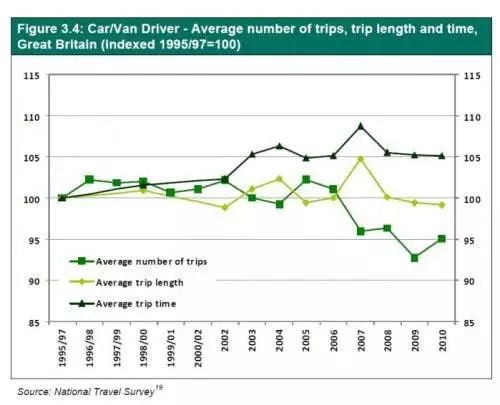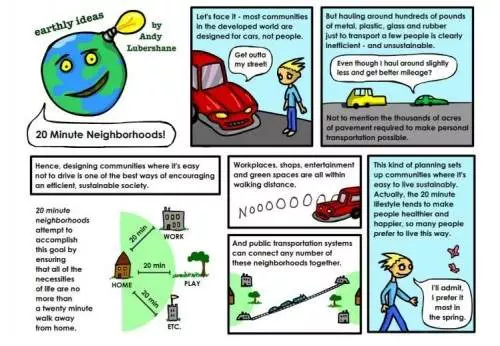
One of the by-products of living through this recession is that for the first time in my living memory the national amount of car trips has gone down. Not only have the amount of trips gone down but the average speed has gone down also (the last time this happened was when in the fuel strikes in 2000). The average speed in London is now 7mph.
Decreasing travel, coupled with a stagnant house market, is perversely the ideal conditions for us to re-invest in our communities. One of the most destructive forces in communities has been the growth of car travel along with our houses being more of a commodity than a choice of where to root ourselves. The effect of traffic on our home lives was first researched by Donald Appleyard in the 1970s. The research was repeated in 2008 in Bristol, and showed that rising amounts of traffic in a street not only cuts down the social interactions on the street but also has a deep effect on the number of friends and the way we view our living space.
Revisiting Donald Appleyard’s Livable Streets from Streetfilms on Vimeo.
By travelling more by walking, cycling and public transport we can begin to glue the community back together. Social interaction is much higher by all of these ways of travelling than by car. Travelling less by car also has a potential to grow our local economy. It is now apparent that retail space at transport nodes has become much more valuable and that the kind of shopping we do there is of a different nature. M&S and smaller scale supermarkets have proliferated and sell subtly different stock ranges. This is quite a different type of shopping to the car based supermarket run, it’s little and often and places a higher value on quality than quantity, and of course we are restricted by what we can carry.
In Portland, Oregon the concept of the ‘20 minute neighbourhood‘ was developed. This is the idea that you should be able to get all the important things in life within a 20 minute walk from your house. It’s not just about shops and services either, the neighbourhood can also have a sense of place with small parks and ambience that makes us want to stick around.

(http://www.worldchanging.com/archives/009750.html)
In the UK there are some places where this works quite well, some places in London, especially in Inner London have developed a richness of shops, amenities and parks. There are now a growing number of planners calling for compact urban design and high density mixed use developments (such as @BrentToderian in Canada). I like where I live and to be honest most of the time our family has no need for a car and I also like many of the people that live around me. I see my next door neighbour catching the bus most mornings as I cycle past, my children see many of their friends when we walk to the local shops, and the school playground is not the only place of social interaction round here.
Transport choice has an important role to play on social cohesion. It’s not all just the nice stuff, it’s so much easier to challenge someone else’s (perceived) bad behaviour if you recognise them or you know their name. It is impossible to live in cities without friction, but knowing people and talking either directly or to mutual friends helps us understand, complain or learn to appreciate each other. Otherwise it’s all just bottled up and used against where we live, followed by moving out. I’m a great believer in sharing public space like parks and not moving to places where everyone has gardens. Walking, cycling and catching the bus doesn’t have to be just a functional process, each is a small step in sticking our communities together and investing our time and money into growing our local economy. If we shop local we have very direct role in creating local employment and keeping the wealth in our community .
The alternative is cloned neighbourhoods where we live separate lives and shop in cloned shops. One of the greatest assets that we have in our neighbourhoods is a sense of the history and if we stay long enough this builds up in layers, on a personal level as well as on a community level, creating a greater sense of ‘place’.
This blog post is a follow up to a recent cultural conversation we hosted with passenger transport organisation Metro.
Have you heard of eco-cities and bioregionalism? I’ve read a number of books on the subject recently, and it is exactly what you’re talking about (and onwards to extremes, of course).
Unfortunately, from all available evidence the Council are encouraging precisely the opposite of what you propose: they want people to get in their cars, drive into the centre, pay an extortionate price for parking, spend a fortune in the ever-increasing number of malls, and then head home for their suburban areas that have no local high street left except the odd betting shop and numerous fast-food emporia. The alternative is to head to the numerous retail parks – only accessible by car.
Lunacy.
Hi Alison
Yes I do know a bit about Eco-cities. I think the new malls are mostly in the centre of Leeds and there don’t appear to be many new out of town shopping centres being built. I think the main problem that we face is escalating bus fares. I think there is evidence both ways as the council appears to hedge its bets, on the one hand its business as usual with car parking (the revenue tops up the council coffers) but on the other hand there is more investment in sustainable travel than ever before (the Local Sustainable Transport fund).
Lets keep the conversation going – I’d like to know the Yorkshire Action on Eco- Cities – I think Sheffield is very active.
Pete